Effect of Combined Application of FYM, Fly Ash and Fertilizers on Soil Properties and Paddy Grown on Degraded Land
Bharat Lal1 * , Vinod Nayak1 , Priyanka Sharma1 and K. Tedia1
1
Department of Soil Science and Agricultural Chemistry,
IGKV,
Raipur,
India
DOI: http://dx.doi.org/10.12944/CWE.9.2.38
Copy the following to cite this article:
Lal B, Nayak V, Sharma P, Tedia K. Effect of Combined Application of FYM, Fly Ash and Fertilizers on Soil Properties and Paddy Grown on Degraded Land. Curr World Environ 2014;9 (2) DOI:http://dx.doi.org/10.12944/CWE.9.2.38
Copy the following to cite this URL:
Lal B, Nayak V, Sharma P, Tedia K. Effect of Combined Application of FYM, Fly Ash and Fertilizers on Soil Properties and Paddy Grown on Degraded Land. Curr World Environ 2014;9(2). Available from: http://www.cwejournal.org/?p=6621
Download article (pdf) Citation Manager Publish History
Select type of program for download
| Endnote EndNote format (Mac & Win) | |
| Reference Manager Ris format (Win only) | |
| Procite Ris format (Win only) | |
| Medlars Format | |
| RefWorks Format RefWorks format (Mac & Win) | |
| BibTex Format BibTex format (Mac & Win) |
Article Publishing History
| Received: | 2014-06-12 |
|---|---|
| Accepted: | 2014-08-14 |
Coal is a predominantsource of global energy; at present in India it is major source of electrical energy in thermal power plants, which produce 175 milliontonnes per year fly ash, which would require about 40,000 hectares of land for the construction of ash ponds (Lalet al., 2012). Fly ash an amorphous ferroalumino silicate, Physically fly ash occurs as fine particles (60-70%) with a size below 0.075mm is a byproduct of pulverized coal fired thermal power station low to medium bulk density, high surface area and very light texture with pH rangedfrom 4.5 to 12 depending upon S content in the coal (Lal et al., 2012). It can act as a secondary source of fertilizer nutrients like P, K , Ca, Mg, S, Cu, Fe, Zn, Mn, Mo etc. (Totawat et al., 2002). Fly ash increasedthe yield in various crops by 20-25 % with high nutritional value and found beneficial for soil and crop when fly ash was applied on soil> 10%by weight (Yavarzadehet al., 2012). Hence, an experiment was conducted with the objective to find out the effect of enriched fly ash on soil health, growth and yield in degraded land.
Materials and Methods
A field experiment was conducted in asandy loamsoilat the KVK Research Farm, Janjgir Champa,Chhattisgarh during the kharifseason, 2013-14. Theexperiment design was randomized block design comprised of eight treatment combinations with three levels of fly ash (20, 40 and 60t ha-1) and two levels of FYM ( 0 and 5 t ha-1). Fly ash and FYM applied as perthe treatments before transplanting the rice. All the plots received the 75 percent of general recommendeddose (GRD)of NPKfertilizers (100-60-40 kg ha-1) except control and 100 percent GRD. Thericevar.MTU-1010 was used as the test crop. The fly ashwas collected from Madhya Bharat Paper Ltd. Village – Birgahni Champa Dist.- Janjgir Champa, Chhattisgarh. The nutrient contents of used FYM and Fly ash applied in the experiment was given in Table 1.
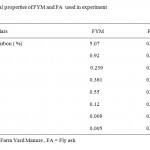 |
Table 1: Chemical properties of FYM and FA used in experiment Click here to View table |
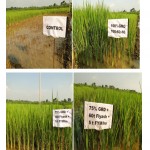 |
Figure 1: Effect of different fly ash treatments on crop growth Click here to View Figure |
The effect of different treatments wasevaluated in terms of soil available major and micro nutrients at crop harvest and the crop yield. Available nitrogen wasestimated by alkaline potassium permanganatemethod(Subbaiah and Asija, 1956). Availablephosphorus content was extracted by Olsen’sreagent and determined by ascorbic acid method (Watanabe and Olsen, 1965). Available potassium was extracted by usingneutral normal ammonium acetate (Muhr et al.,1965) and determined by flame photometer. Organic carbon was determined by Walkley and Black rapid titration method as described by Piper (1957) and storage calculate 0-10 cm depth of soil with having bulk density. Available micronutrients (DTPA extractable) Fe, Mn, Cuand Zn were analyzed by DTPA method usingatomic absorption spectrophotometer (Lindsayand Norvell, 1978).
Results and Discussions
The soil belongs to sandy loam texture and the soil status was low in available nitrogen, phosphorus and high in potassium (Table 3). The soil available micronutrientswere above the critical limits except for Zn (Table 4). The control plots failed to produce the yield due to very low N and P status of soil (fig. 1 and Table 2 ,3). The application ofdifferent treatment combinationsexcept 75% GRD + 20t Fly ash ha-1 with and withoutFYM increased the grain yield compared to General recommended dose (GRD). The highest grain yield (42.6 q ha-1) was recordedby application of 75% GRD + 60 t FAha-1 + 5 t FYMha-1, which was at parwith 75% GRD+ 40 t FAha-1+5t FYMha-1. Thus application of fly ash not only increased the paddy yield by 30% but also saved the 25% of NPK fertilizer. The straw yield was significantly higher in different treatments over control and further combinationof fly ash with or without FYM was found similar to GRD but showed at most 8.42% increased in straw yield.The supply of nutrients, conductive to physical environmentleading to better aeration, root activity andnutrient absorption and the consequentcomplementary effect by fly ash application with organic and inorganic fertilizer would have resulted inhigher grain and straw yield of rice this finding are in conformity with that of Reddyet al .,(2010). The beneficial effect of fly ash on yield was also reported by Aggarwalet al.(2009) in wheat and sorghum and by Arivazhagan et al. (2011) in rice, wheat, maize, ragi.
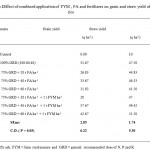 |
Table 2: Effect of combined application of FYM, FA and fertilizers on grain and straw yield of rice Click here to View table |
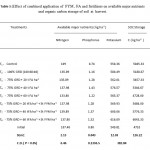 |
Table 3: Effect of combined application of FYM , FA and fertilizers on available major nutrients and organic carbon storage of soil at harvest. Click here to View table |
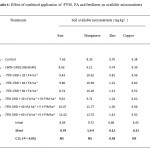 |
Table 4: Effect of combined application of FYM , FA and fertilizers on available micronutrients Click here to View table |
An increase in soil available major and micronutrients status ondegraded soil was observed (Table 3 and 4). The soil available N statuswas significantly higher by the application of the treatments over control. The soil test Phosphorus was significantly higher under the combined treatment over 100% GRD and control, the treatments 75% GRD + 60t FAha-1 + 5t FYM ha-1 and 75% GRD+ 40 t FAha-1 + 5 t FYMha-1showed higher soil test P compared to GRD. Similarly in different FA combination treatments 75% GRD + 60t FAha-1 + 5t FYM ha-1and 75% GRD+ 40 t FAha-1 + 5 t FYMha-1over GRD showed higher available K status in soil, further the fly ash when combined with organic and chemical fertilizer showed remarkable increase in soil available K over 100% GRD. The organic carbon storage was increased with the combination of treatments and was maximum in 75% GRD + 60t FAha-1 + 5t FYM ha-1(6063.33 kg ha-1 ) as compare to GRD and control. The application of 75% GRD + 60 t FAha-1 + 5 t FYMha-1 has recorded higher available Zn as compare to 100% GRD and control ( Table 4). The Fe , Mn and Cu content was not influenced by the different combination of treatments. The increase in soil available major nutrients status due to fly ash application was reported by Khanet al. (2008) andRamet al. (2011) the increase in available major nutrients except K concluded by Dey et al. (2012).The organic carbon was increased application of FA and FYM reported by Karmakaret al., (2009). The beneficial effect of fly ash on improvement of soil health in respect of physico-chemical parameters, nutritional status and microbial population may be due to the cumulative effect of improvement in individual physico-chemical characteristics ( Yeledhalliet al.,2008).
Acknowledgement
The authors are grateful to the Head and advisor Department of Soil Science and Agricultural Chemistry, College of Agriculture, IGKV, Raipur for providing Laboratory facilities and co-operation of Krishi Vigyan Kendra, Janjgir Champa is also acknowledged.
References
- Lal, k., Chhabra, R., Mongia A.D. , Meena, R.L.and Yadav, R.K. Release and uptake of potassium and sodium with fly ash application in rice on reclaimed alkali soil. J. Indian Soci. of Soil Sci.60:181-186 (2012) .
- Tatawat , K.L., Nagar, G.L., Jat, S.L. and Jangir, R. K. In: Symposium on effect of fly ash on the performance of wheat on ustochrepts of sub – humid plains of India, held during 14-21 August 2002, Thailand , Symposium no. 24 , paper no. 215, pp 1-11 (2002).
- Yavarzadeh , M.R. and Shamsadini, H. Safe environment by using fly ash and vermicompost on wheat. In:International conference on transport, environment and civilengineering, held during 25-26 August 2012 at Kuala Lumpur (Malaysia), pp 146-148 (2012).
- Reddy, T.P., Umadevi , M . and Rao, P.C. Effect of fly ash and farm yard manure on soil properties and yield of rice grown on an inceptisol. Agric. Sci. Digest., 30(4) : 281–285 (2010).
- Aggarwal, S., Singh, G.R. and Yadav, B.R. Utilization of fly ash for crop production: Effect on the growth of wheat and Sorghum Crops and soil properties. J. Agril. Physics9, 20-23 (2009) .
- Arivazhagan, K., Ravichandran, M., Dube, S.K., Mathur, V.K., Khandakar, R.K.,Yagnanarayana, K., Pasha, M.M.K., Sinha, A.K., Sarangi, B.D., Tripathi, V.K.M., Gupta, S.K., Singh, R., Ali, M., Thakur, A.S. and Narayan, R. Effect of coal fly ash on agriculture crops: show case project on use of fly ash in Agriculture in and around Thermal power station area of national thermal power corporation Ltd., India. World of Coal Ash (WOCA) Conference- May 9- 12, 2011, in Denver, CO, USA (2011) .
- Khan, M.J. and Qasim, M. Integrated use of boiler ash as organic fertilizer and soil conditioner with NPK in calcareous soil . Songklanakarin J. Sci. Tech. 30 (3): 281-289 (2008).
- Ram, L.C., Masto, R.E., Singh, S., Tripathi, R.C., Jha, S.K., Srivastava,N.K., Sinha, A.K .,Selvi, V.A. and Sinha, A. An Appraisal of Coal Fly Ash Soil Amendment Technology (FASAT) of Central Institute of Mining and Fuel Research (CIMFR). World Aca. of Sci., Engi. And Tech.52 : 703-714 (2011).
- Dey, B.S., Panigrahi, S., Panigrahi, T. and Panda, R.B. Agricultural utilization of fly ash – a way for sustainable agriculture practice and its environmental significance.Discovery Nature1 (1): 11-14 (2012).
- Karmakar, S., Mittra , B.N. and Ghosh , B.C. Influence of Industrial Solid Wastes on Soil-Plant Interaction in Rice Under Acid Lateritic Soil. World of Coal Ash (WOCA) Conference held May 4 -7 , 2009 in Lexington, KY,USA (2009).
- Yeledhalli, N.A., Prakash, S.S., Ravi, M.V. and Narayanarao, K. Long term effect of fly ash on crop yield and soil properties. Kar. j. of Agric.Sci. 21 (4): 507-512 (2008).







